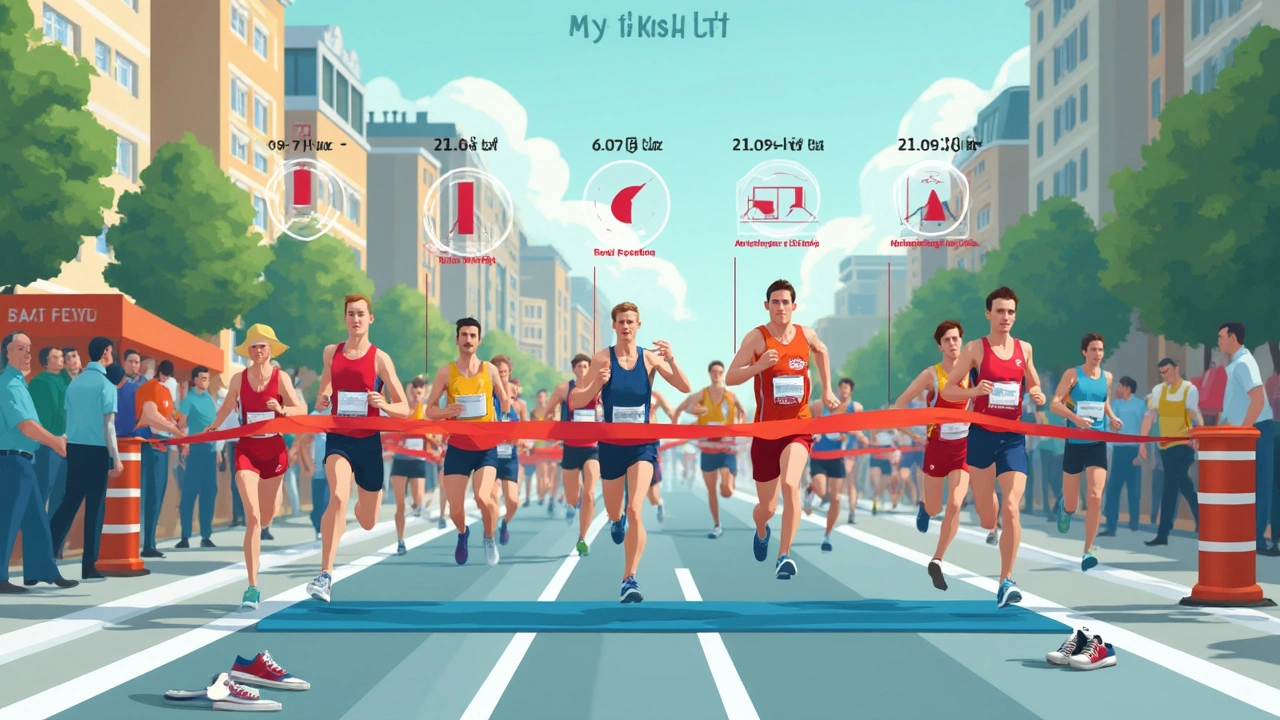If you’ve ever scrolled through race results and wondered if your marathon time would stack up, you’re definitely not alone. The big number everyone asks: how long does it actually take to finish a marathon? The average marathon finish time worldwide is about 4 hours and 30 minutes, but there’s a lot more to the story—age, experience, gender, training style, and even weather can swing that number one way or the other.
For most first-timers, finishing the 26.2 miles at any pace is a win. But if you’re anything like me, you want to know what a “normal” result looks like and how you can nudge yourself into a better bracket. And here’s the kicker—just training smarter, not always harder, can shave minutes (sometimes even an hour) off your result.
Before we dive into the details, you should know averages are just a starting point. Your personal marathon journey looks different from everyone else's—whether you’re racing on city streets or grinding through endless treadmill miles while your kid draws you good-luck signs. Next, let's get specific about what finish times really mean and who is breaking which barriers.
- What Is the Average Marathon Time?
- Factors That Change Your Finish Time
- How to Set a Realistic Marathon Goal
- Tracking Your Progress with Pace Charts
- Tips to Improve Your Marathon Finish Time
What Is the Average Marathon Time?
There’s always buzz around marathon finish times. If you plug your name into a big city marathon database, you’ll see finishing times spread out from just a bit over two hours to eight hours or more. Most runners don’t come near that sprint by the pros, though. According to the 2023 World Marathon Majors stats, the average marathon time for all runners—men and women, all ages—is around 4 hours 30 minutes. For men specifically, that number drops to roughly 4 hours 20 minutes, while for women it’s about 4 hours 50 minutes.
For first-timers, the national average in the U.S. ticks closer to 4 hours 45 minutes, based on data from the Boston Marathon and New York City Marathon in 2023. A lot of people take even longer, and that’s completely normal.
Times really spread out as you look at different groups:
- Elite men: Usually finish between 2:02 and 2:10 (think of guys like Eliud Kipchoge).
- Elite women: Top women cross the line in about 2:15 to 2:25.
- Age 30–39 men: Average finish is about 4:05.
- Age 30–39 women: Average is about 4:35.
- Many recreational runners: 4:30 to 5:30 is absolutely standard.
The website Marathon Handbook explains:
"Over 1.1 million people finish a marathon every year, and most of them are hobby runners just aiming to cross the line upright. Four and a half hours is roughly the finished median, and finishing is the real goal for most people.”
Bottom line, you’re in good company even if you’re nowhere close to running with the pros. If you finish somewhere between four and five hours, you’re dead center in the pack. And if you’re a beginner, don’t sweat the numbers—you’ve already beaten all the people who never start.
Factors That Change Your Finish Time
Everyone talks about averages, but marathon finish times are all over the map. Several factors play a serious role in how long it takes you to cross the finish line. If you’re eyeing your own marathon average time or wondering why your pace doesn’t match your friend’s, here’s what’s really at work.
Age and Gender are two big ones. Most marathoners peak somewhere in their late 20s to late 30s, though age groups up to the 50s can still lay down fast times. On the gender side, men typically finish a marathon about 30 to 40 minutes faster than women on average, but the gap’s been closing over the years.
| Category | Average Time |
|---|---|
| Overall | 4:30:00 |
| Men | 4:20:00 |
| Women | 4:50:00 |
| First-time Runners | 5:00:00 |
Fitness Level and Training have a huge impact. Runners logging more weekly miles, following a plan, and mixing in intervals or long runs see consistent improvements. If you’re just lacing up for weekend jogs and hoping for the best, you’ll naturally finish behind those clocking in quality workouts each week.
Course and Weather can either help or wreck your finish time. Flat or downhill courses, like Berlin or Chicago, produce faster results than routes stacked with hills (Boston is notorious for its rolling terrain). High temps, humidity, wind, or rain slow everyone down—sometimes by 10-15 minutes or more if the weather’s brutal.
Here’s the stuff that really matters when you’re sizing up your potential marathon time:
- Your weekly mileage and consistency — Building up gradually keeps injuries away and locks in faster paces.
- Nutrition and hydration — Running on empty or getting dehydrated causes huge drop-offs late in the race.
- Experience — Your first go at 26.2 will almost always be slower than your next, once you know the rhythm and how your body reacts.
- Race day strategy — Setting out too fast is the classic mistake, leaving you to crawl the final miles. Even pacing or negative splits (speeding up a little in the second half) usually gives you the best result.
Knowing these factors helps you spot where you can actually make changes—skip the guessing and work on what really makes a difference in your running outcomes.

How to Set a Realistic Marathon Goal
Trying to pick a marathon goal? Start with where you’re at right now, not where you wish you were. Loads of runners shoot for a big stretch goal and end up disappointed, or worse, injured. Here’s a smarter way to map out your target and actually cross the finish line smiling.
First, check out your recent race results. If you’ve done a half marathon in the last six months, you can ballpark your time for twice the distance. A good rule: double your half-marathon time, then add 10-20 minutes. This extra chunk factors in the fatigue and muscle breakdown that just hits differently in the late marathon miles.
Here’s a handy chart showing marathon goal times based on half marathon results:
| Recent Half Marathon Finish | Estimated Marathon Goal |
|---|---|
| 1:45:00 | 3:45:00 – 4:00:00 |
| 2:00:00 | 4:10:00 – 4:25:00 |
| 2:15:00 | 4:35:00 – 4:55:00 |
| 2:30:00 | 5:00:00 – 5:20:00 |
If you haven’t raced recently, try a training run of an hour at a steady pace. Check your average mile pace, and use this marathon average time formula: your mile pace x 26.2, then add 10%. That covers the slowdown from running further than you likely ever have before.
Don’t forget life stuff: work stress, sleep (or lack of—shoutout to parents), your current training volume, and even your local weather should play into your goal. Adjust downward if you know you won’t get most long runs in or if training through hot, muggy days is a guarantee.
- Use races or time trials to update your goal mid-training.
- Set an “A” goal (best case), a “B” goal (solid day), and a “C” goal (just finish it).
- Be honest with yourself—the race rewards pacing, not ego.
At the end, it comes down to realistic optimism: trust your training, but set a target you can actually hit with the work you’ve done, not just the one you post about on Instagram. Your body—and your finish photo—will thank you for it.
Tracking Your Progress with Pace Charts
Keeping up with your marathon training is way less stressful when you have a clear picture of your pace. That’s where pace charts come in. These handy guides show you what time you should hit every mile or kilometer if you want to finish in your goal time. Whether you’re chasing a 4-hour finish or just hoping to crack 6 hours, a solid pace chart breaks it all down by split—no phone math required.
Here’s how most runners use them: Pick your target finish time, let’s say 4:30:00, and a chart will tell you that’s roughly 10 minutes, 18 seconds per mile, or 6 minutes, 24 seconds per kilometer. Suddenly, you know if you’re on track after every split. Most big marathons even hand out wristbands or printouts with time splits for popular goal times, so you don't have to memorize anything.
If you want a custom pace, a lot of marathon training apps let you punch in your own target and even your expected fade in the last miles (because, let’s be honest, most of us slow down at the end). These tools are way more accurate than just ballparking your speed or trusting your gut on race day. The best move? Practice running at your goal pace during training, then compare your training runs to the chart. If you’re consistently off by a minute or two, you’ll see it early and can adjust before the big day.
- Download a free pace chart online or use a mobile app that customizes splits to your personal goal.
- Stick your splits on your watch, phone, or even make a waterproof wristband.
- Don’t wait for race day—use the chart during your longest training runs to practice staying on pace.
- Make a note of your slowest and fastest miles and see how they stack up to your *marathon average time* target.
Being realistic about your pace means less guesswork, more confidence on the course, and fewer surprises when you cross that finish line. Trust me, tracking your splits pays off—especially when your legs start to disagree with your racing ambitions around mile 20.

Tips to Improve Your Marathon Finish Time
If you want to see a faster number next to your name at the finish line, it’s all about targeted changes in your training and race day habits. Small tweaks can actually make a big difference, even for folks who aren’t running sub-3-hour marathons. Here’s a breakdown of what really works:
- Focus on long runs and consistency: One of the best predictors of a solid marathon average time is sticking with your long runs every week. It’s tempting to skip them, especially when life gets busy or the weather stinks. But showing up—even for a slow, ugly long run—trains your legs and your mind to handle 26.2 miles when it really counts.
- Mix up your workouts: A lot of runners just pound out miles at the same easy pace. But adding tempo runs, intervals, or hill repeats helps your body get more efficient. According to research from the Journal of Strength and Conditioning, runners who included weekly speedwork dropped their marathon times by an average of 5-10% in a single season.
- Strength training matters: Stronger muscles help you keep good form as you get tired. Just two short strength sessions a week—think squats, lunges, or core work—reduce your risk of injury and help you power through the final miles. Don’t worry about bulking up; you’ll stay lean and fast.
- Nail your race day fuel: It sounds obvious, but a lot of folks mess up their nutrition. Practice eating and drinking during your long runs so you know exactly what your stomach can handle. Popular advice is to take in 30-60 grams of carbs per hour, but everyone’s needs are a little different.
- Don’t ignore recovery: Hard training is where you build fitness, but real improvement comes from rest. If you’re always exhausted or getting little injuries, dial back. Better to show up slightly undertrained than limping to the start line.
One last tip: If you’re getting serious, try running with others. Whether it’s a running club, a coach, or just a neighbor, having some company and accountability is a game-changer for motivation. There’s nothing like a friendly rivalry to keep you chasing those marathon average time milestones.








